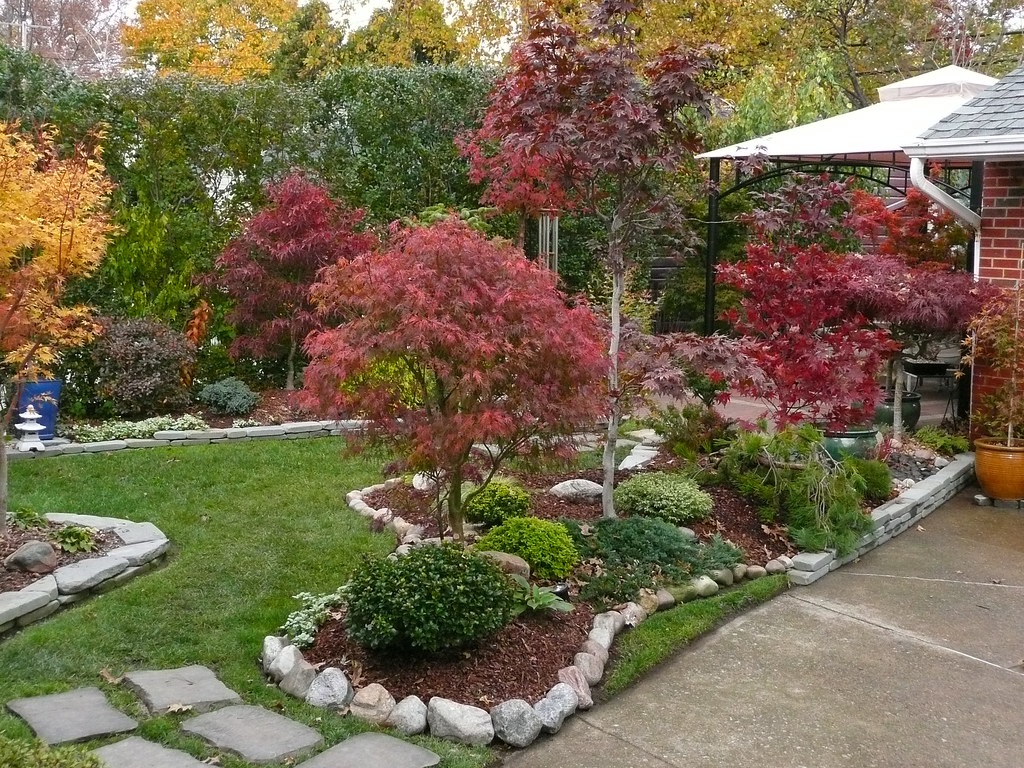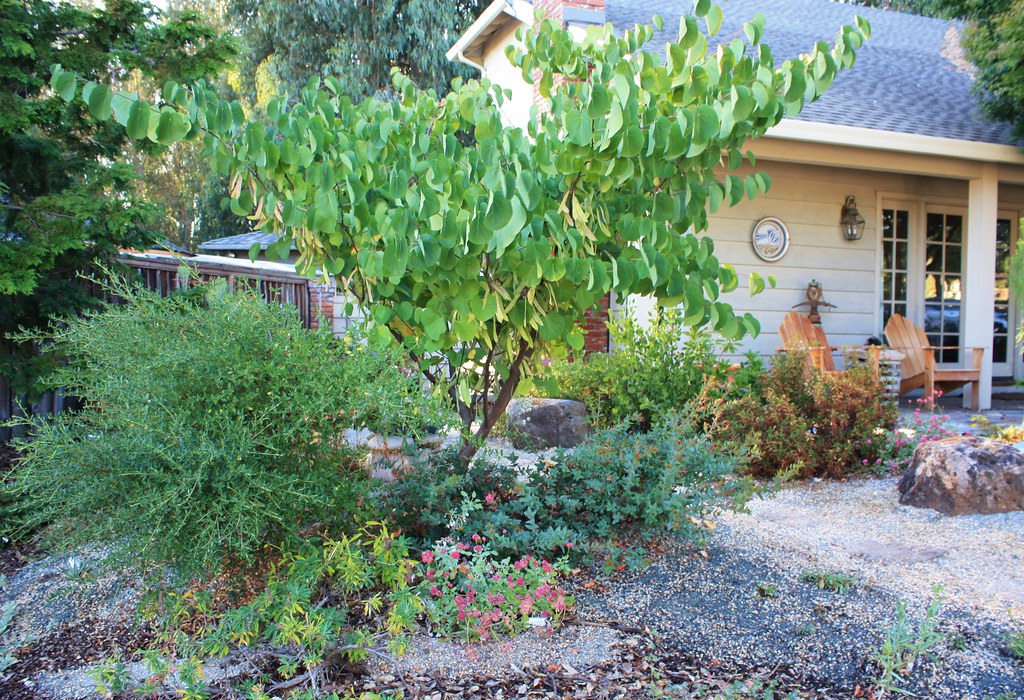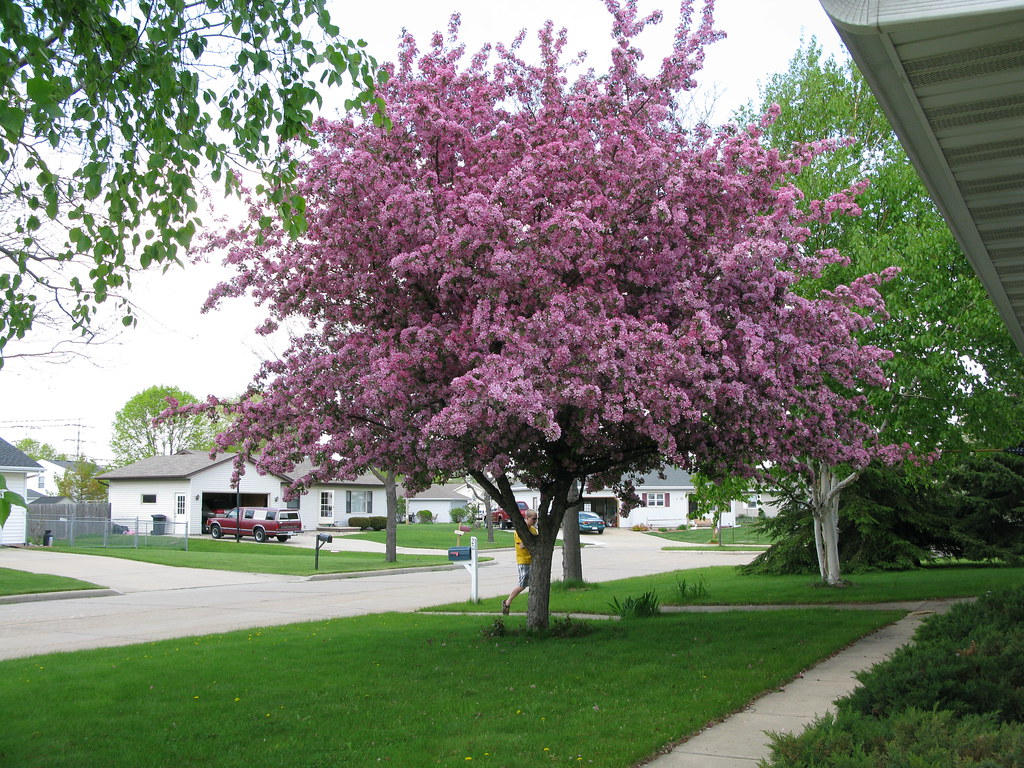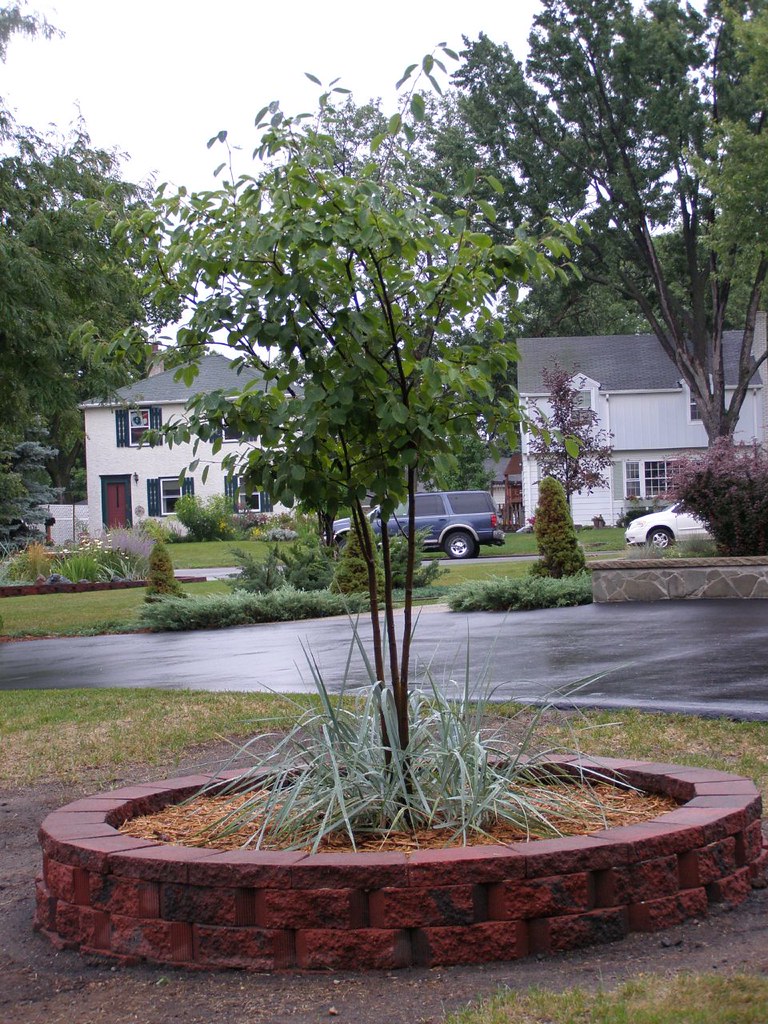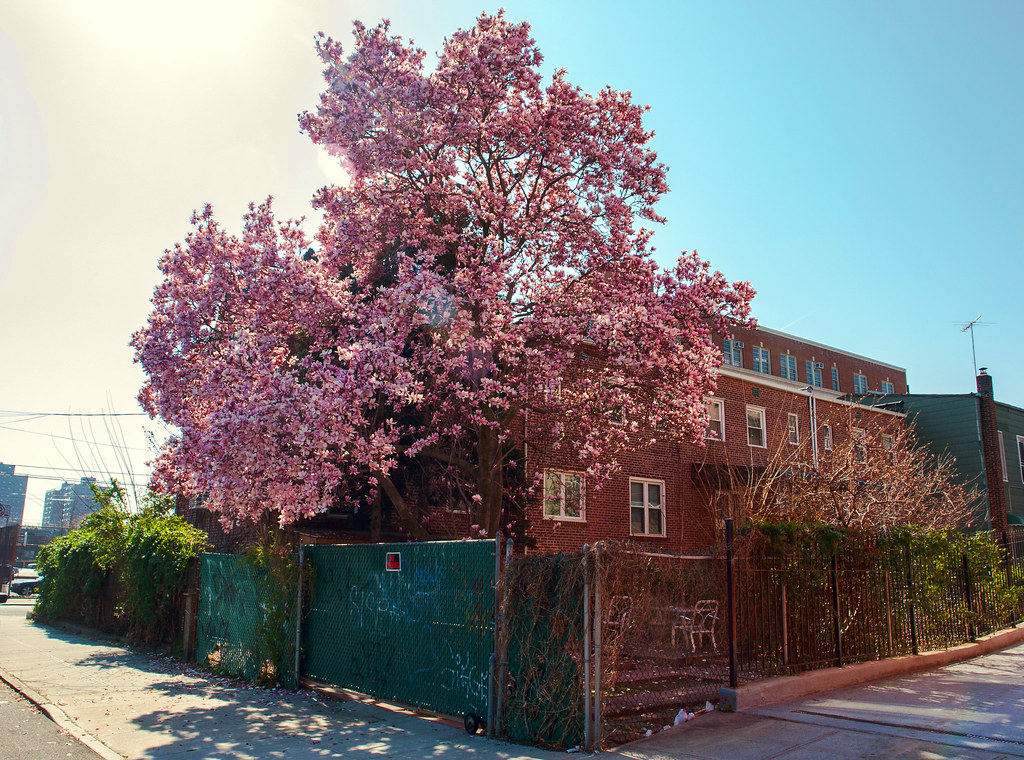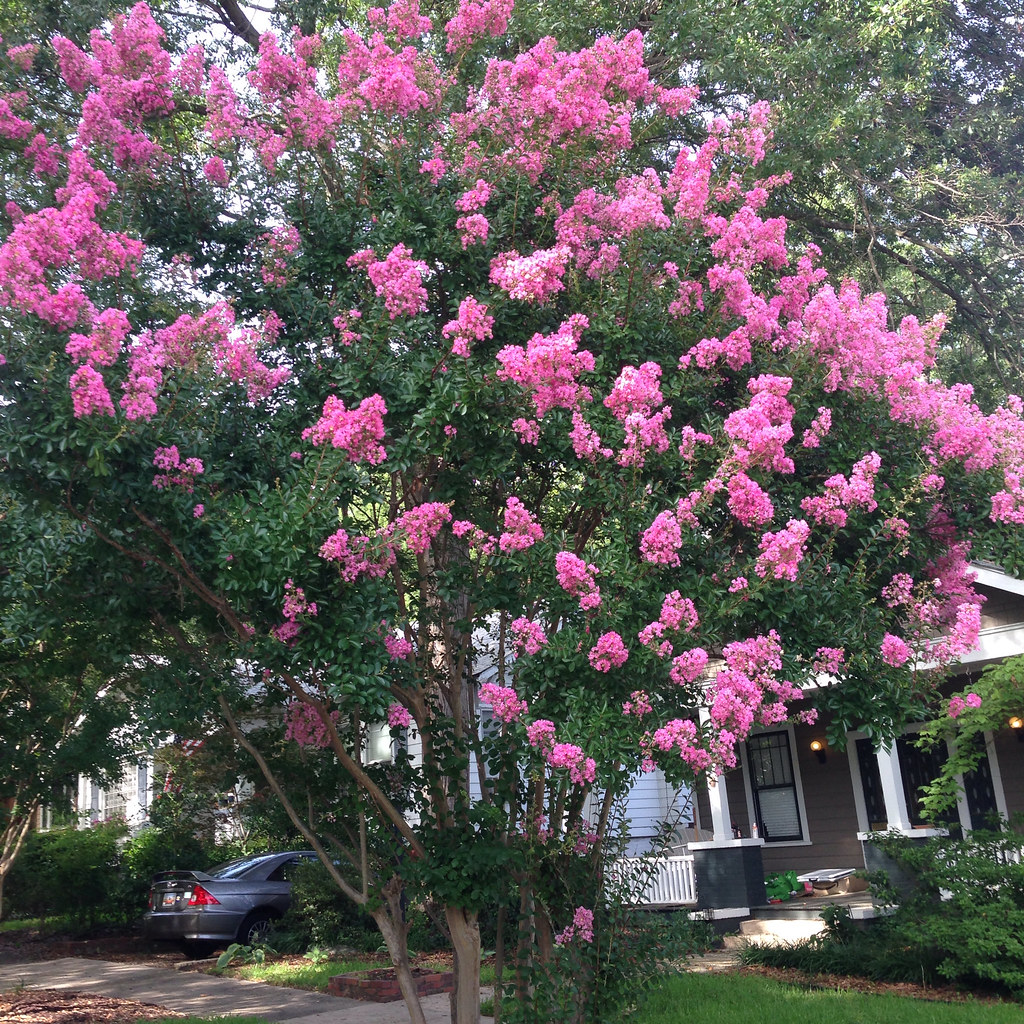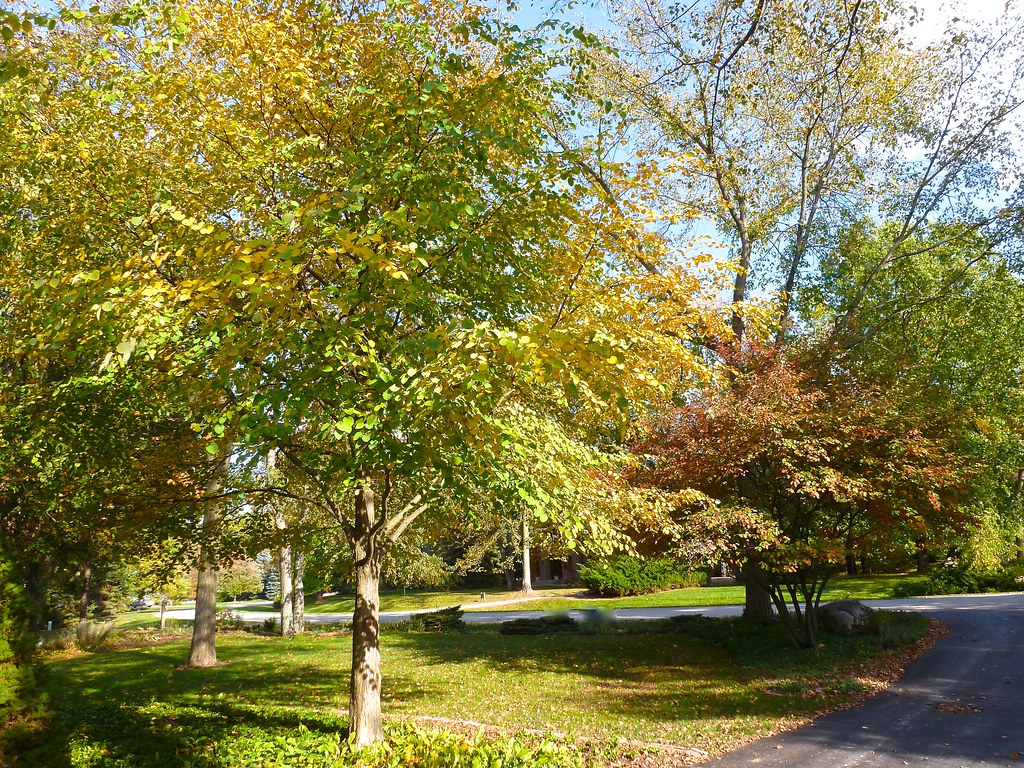Disclaimer: This article contains affiliate links. If you click on links we provide, we may receive compensation.
Trees can make a big difference in how your home looks from the street. They provide shade and can even boost your property’s value. But when you don’t have much space, picking the right tree becomes very important. You wouldn’t want a huge tree taking over your yard or roots causing problems with your house’s foundation.
The good news is that many attractive, easy-care trees do well in smaller areas. You can find options that look great all year, have pretty flowers, or just add a touch of elegance to your yard.
We’ve put together a list of 10 trees that work perfectly in small front yards, helping you make the most of your outdoor area without giving up on style or usefulness.
Japanese Maple
The little decorative Japanese maple tree is well-known for its exquisite foliage and vibrant fall foliage. This species grows slowly; it usually reaches a height of 15 to 25 feet, however some dwarf variants never grow higher than 10 feet.
With its lovely bark and beautiful branches, it provides year-round interest. It has leaves that range in color from pale green to deep burgundy and is available in a number of cultivars, from weeping to upright forms.
‘Bloodgood,’ with its purple foliage, and ‘Coral Bark,’ with its bright red winter stems, are two popular kinds. Japanese maples grow well in small gardens or pots and can withstand some shade.
They like slightly acidic, well-drained soil and are shielded from the intense afternoon sun and breezes.
- USDA Hardiness Zones: 5-8
- Size: 15-25 feet tall and wide
- Root System: Shallow, fibrous, spread 1-3 times the canopy width
- Maintenance requirements: Low; annual pruning in late winter, occasional leaf cleanup
Dogwood
Small deciduous dogwood trees are well-known for their brilliant springtime blossoms. The characteristic four-petaled flowers appear in white, pink, or crimson before the leaves. Later on, it bears vivid red berries that draw birds. In the fall, dark green leaves take on a reddish-purple hue, adding interest throughout the year.
Cornus florida and Cornus kousa, or Korean dogwood, are common species. Both do well on acidic, well-drained soil that is partially shaded.
Dogwoods usually reach a height of 15 to 30 feet; smaller areas are better suited for dwarf types like ‘Little Poncho’. The flower “Cherokee Brave” has rich pink blossoms. For best growth, these trees need cover from the intense afternoon sun and steady rainfall.
- USDA Hardiness Zones: 5-9
- Size: 15-30 feet tall, 15-25 feet wide
- Root System: Shallow, spreading, typically within top 12 inches of soil
- Maintenance requirements: Low to moderate
Redbud
Before leaves sprout, the redbud tree, a sign of spring, explodes with clusters of magenta blossoms along its limbs. Small and endemic to North America, this tree has heart-shaped leaves that turn yellow in the fall after emerging bronze-red and maturing to dark green.
Redbuds may grow in a variety of soil types and do well in full sun to partial shade. Cercis canadensis is a plant that grows to a height of 20 to 30 feet, although smaller gardens work well with compact cultivars like ‘Forest Pansy’.
Its interesting pea-like seed pods keep coming back throughout winter. In addition to drawing pollinators, redbuds are host plants for a number of butterfly species.
- USDA Hardiness Zones: 4-9
- Size: 20-30 feet tall, 15-25 feet wide
- Root System: Moderately shallow, spreading; can be twice the canopy width
- Maintenance requirements: Low; occasional pruning, some leaf and pod cleanup
Crabapple
With their abundance of pink, white, or crimson blooms, crabapple trees provide a breathtaking springtime display. These small to medium-sized deciduous trees give year-round interest, featuring gorgeous foliage, colorful fruit, and fascinating bark.
The fruits, which are smaller than typical apples, are available throughout the winter and feed birds. Crabapples can be weeping or columnar, according on the requirements of the environment. Disease-resistant cultivars such as ‘Sugar Tyme’ and ‘Prairifire’ require less care.
The majority of crabapples can tolerate a wide variety of pH levels and appreciate full light and well-drained soil. They grow well in groups or as specimen trees because of their small stature, which makes them perfect for urban gardening.
- USDA Hardiness Zones: 4-8
- Size: 15-25 feet tall, 15-20 feet wide (varies by cultivar)
- Root System: Moderately shallow, spreading; typically extends to drip line
- Maintenance requirements: Moderate; annual pruning, fruit and leaf cleanup
Hawthorn
Compact and resilient deciduous trees with prickly branches, hawthorn trees are attractive in the fall. In April, they produce clusters of white or pink blooms, enticing pollinators. These blossoms give way in the fall to tiny, vivid red berries that stay through the winter and feed the birds.
In the fall, the deeply lobed leaves take on crimson and orange hues. Hawthorns can tolerate a range of soil conditions and grow well in full sun to partial shade. Common species that reach 15–25 feet in height are Crataegus monogyna.
These trees make great wildlife habitat and are frequently utilized as display plantings or in hedgerows. Some kinds, like ‘Paul’s Scarlet’, offer double blossoms for added visual appeal.
- USDA Hardiness Zones: 3-9
- Size: 15-30 feet tall, 15-25 feet wide
- Root System: Deep, spreading; can extend beyond the canopy
- Maintenance requirements: Low to moderate; occasional pruning, some fruit cleanup
Serviceberry
With its beautiful fall leaves, tasty blue-purple berries in July, and early spring white blossoms, serviceberry trees provide appeal throughout the year. This little native North American tree grows well in a variety of soil conditions and does well in both full and partial sun. Serviceberries are 15–25 feet tall and make excellent understory trees or small garden plants.
The fruit is good for jams and pastries and attracts birds. Amelanchier arborea and A. canadensis are popular cultivars. Serviceberries are low-maintenance and attractive all year round, with their upright form and smooth gray bark that deters most pests and illnesses.
- USDA Hardiness Zones: 2-9
- Size: 15-25 feet tall, 15-20 feet wide
- Root System: Shallow to moderate, non-invasive
- Maintenance requirements: Low; minimal pruning, occasional fruit cleanup
Star Magnolia
A little, deciduous tree known for its early spring blooms is the star magnolia. Before the leaves, large, star-shaped blooms with plenty of white petals emerge, making a visually arresting show. This tree grows slowly, reaching a maximum height and width of 15-20 feet, which makes it ideal for small gardens.
It is native to Japan and likes well-drained, slightly acidic soil. It also enjoys full sun to partial shade. A lot of other magnolia species are not as cold-hardy as star magnolia. Whereas ‘Rosea’ has pink-tinged blooms, the cultivar ‘Royal Star’ delivers larger flowers. Fall brings yellowing leaves that drop, while fuzzy buds give winter interest.
- USDA Hardiness Zones: 4-9
- Size: 15-20 feet tall, 10-15 feet wide
- Root System: Shallow, fibrous, spreads to drip line or slightly beyond
- Maintenance requirements: Low; occasional pruning, some leaf and seed pod cleanup
Dwarf Alberta Spruce
The evergreen dwarf Alberta spruce has a characteristic conical shape and grows slowly. This compact, pyramid-shaped tree is perfect for small gardens or containers because it usually grows to only 6 to 8 feet tall. Its densely packed, soft, brilliant green needles give it a smooth, almost velvety appearance.
It is native to Alberta, Canada, and grows best on soil that drains well in full light. Highly cold-tolerant, it’s suited for northern climes. This low-maintenance tree makes a great live Christmas tree or rock garden addition, adding structure to landscapes all year round. In exposed areas, protection against winter burn is advantageous.
- USDA Hardiness Zones: 2-6
- Size: 6-8 feet tall, 4-5 feet wide
- Root System: Shallow, compact, extends slightly beyond the canopy
- Maintenance requirements: Low; minimal pruning, occasional needle cleanup
Crepe Myrtle
Popular summer blooming tree crepe myrtle is prized for its showy bark and long-lasting summer blossoms. It is an Asian native that grows well in warm areas and can reach different sizes, from medium-sized trees to shrubs. Flowers might be white, pink, red, or purple, and they grow in bunches.
Winter appeal is added by the smooth, peeling bark of the tree. After they are established, crepe myrtles can withstand heat and drought and appreciate full sun and well-drained soil. Pruning in late winter might encourage more flowers, as they blossom on fresh growth. Popular cultivars include ‘Dynamite’ (red), ‘Zuni’ (lavender), and ‘Natchez’ (white blooms). Before falling, fall foliage frequently turns orange or red.
- USDA Hardiness Zones: 6-10
- Size: 15-25 feet tall, 6-15 feet wide (varies by cultivar)
- Root System: Moderately shallow, non-invasive
- Maintenance requirements: Low to moderate; annual pruning, flower and leaf cleanup
Amelanchier
Amelanchier is a multipurpose little tree or big shrub that is also referred to as juneberry or serviceberry. It has bright fall foliage, tasty purple berries in the summer, and white flowers in the early spring. Reaching a height of 15 to 25 feet, it can tolerate many types of soil and grows well in both full and partial shade.
Amelanchier is a great choice for an understory tree, mixed border, or specimen plant since it draws birds. A. canadensis and A. arborea are common species. It’s a favorite for gardens and natural environments due to its low maintenance requirements and interest throughout the year.
- USDA Hardiness Zones: 4-9
- Size: 15-25 feet tall, 15-20 feet wide
- Root System: Shallow to moderate, non-invasive
- Maintenance requirements: Low; minimal pruning, occasional fruit cleanup
Witch Hazel
With its appealing fall leaves and intriguing bark texture, witch hazel provides year-round interest. It prefers partial shade and well-drained, slightly acidic soil. H. virginiana, or American witch hazel, and H. mollis, or Chinese witch hazel, are common species. Witch hazel, prized for its therapeutic qualities and low maintenance requirements, is a common addition to winter gardens and naturalized areas.
The peculiar blooming time of witch hazel (Hamamelis), which produces distinctive spidery flowers in late fall or winter, makes it highly appreciated. When most plants are dormant, these fragrant blossoms in shades of yellow, orange, or red create a striking display. This deciduous shrub or small tree, growing to a height of 10 to 20 feet, fits in well with a variety of landscape settings.
- USDA Hardiness Zones: 3-8
- Size: 15-20 feet tall, 15-20 feet wide
- Root System: Shallow, spreading; typically extends to drip line
- Maintenance requirements: Low; occasional pruning, minimal leaf cleanup
Japanese Stewartia
The graceful little tree known as Japanese Stewartia (Stewartia pseudocamellia) is highly valued for its multiseasonal beauty. It has beautiful white summer flowers that resemble camellias, exfoliating bark that is quite dramatic, and bright fall foliage. It grows to be 20 to 40 feet tall and likes acidic soil that is moist and well-drained, with moderate shade.
Stewartia is prized for its low maintenance requirements, graceful appearance, and gradual growth. It looks great in woodland gardens or as a specimen tree. It’s a popular option among discriminating gardeners and landscapers because of its unique bark, summer blossoms, and fall color.
- USDA Hardiness Zones: 5-8
- Size: 20-30 feet tall, 15-25 feet wide
- Root System: Shallow to moderate, non-invasive
- Maintenance requirements: Low; minimal pruning, occasional leaf cleanup
Hinoki Cypress
The beautiful evergreen conifer Hinoki Cypress (Chamaecyparis obtusa) has fan-shaped, dark green foliage and peeling bark that is reddish-brown in color. It comes from Japan and is highly valued for its textured look and graceful, pyramidal shape. Though in its natural habitat it can grow to 50 to 75 feet, domesticated variants tend to stay smaller.
Hinoki Cypress is a common specimen tree in Japanese gardens that requires well-drained soil and full sun instead of partial shade. For smaller areas, dwarf cultivars such as ‘Nana Gracilis’ are appropriate. It’s useful in formal gardens and naturalized settings alike because of its low maintenance needs and year-round appeal.
- USDA Hardiness Zones: 4-8
- Size: 15-20 feet tall, 5-10 feet wide (dwarf varieties smaller)
- Root System: Shallow, fibrous, typically extends to drip line
- Maintenance requirements: Low; occasional shaping, minimal needle cleanup
